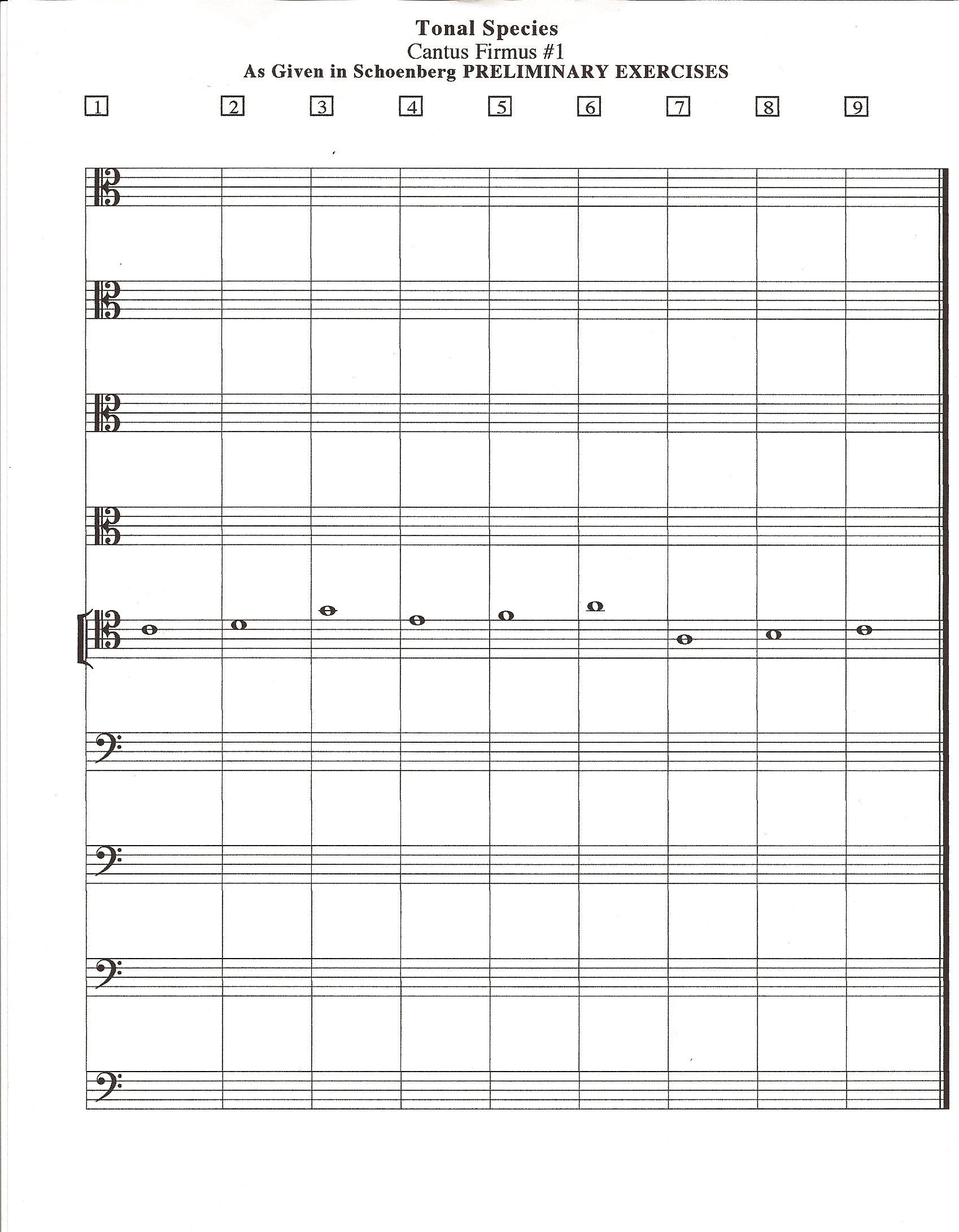by Christopher Fulkerson

Cantus Firmus #1 Worksheet
Here is a simple booklet of sixteen Cantus Firmus Worksheets, such as the one to the right, that I have compiled for use in the study of Counterpoint:
Sixteen Cantus Firmus Worksheets
And a Diagram of the Clefs:
Table of Contents:
#1 Major Mode, Nine tones, from Schoenberg
#2 Major Mode, Twelve tones, from Schoenberg
#3 Major Mode, Eight tones, from Schoenberg
#4 Major Mode, Eight tones, from Schoenberg
#5 Major Mode, Eight tones, from Schoenberg
#6 Major Mode, Eight tones, from Schoenberg
#7 Major Mode, Eight tones, from Schoenberg
#8 Major Mode, Eight tones, from Schoenberg
#9 Dorian Mode, Eleven tones, from Fux
#10 Minor Mode, Eleven tones, from Fux
#11 Phrygian Mode, Ten tones, from Fux
#12 Minor Mode, Twelve tones, from Schoenberg
#13 Hypodorian Mode, Six tones, from Schoenberg
#14 Minor Mode, Eleven tones, from Schoenberg
#15 Minor Mode, Seven tones, from Schoenberg
#16 Minor Mode, Nine tones, from Schoenberg
List of Cantus Firmi 1-11
Diagram of the Clefs and their mutual relationships
And here is a link to Amazon where you can find the only reliable book on the subject:
PRELIMINARY EXERCISES IN COUNTERPOINT by Arnold Schoenberg
Link to Amazon
I made these remarks at Amazon: This is really the only reliable book from which you can hope to study counterpoint, especially if you are like almost all Americans and don't have a counterpoint teacher. Since the study of counterpoint has never been commonly taught in American universities, few teachers can even correct your homework; nevertheless, Schoenberg, without a doubt the greatest musical autodidact of all time, not only gives you exercises in all the species, he shows you examples in which he has written counterpoints to several Cantus Firmuses (you only need a few for the entire course), and explains the strengths and weaknesses of each. So the student can not ponly learn on his own, he has the "classroom homework" remarks by the Master.
PRECEPTS AND PRINCIPLES FOR PLAYING THE THOROUGH-BASS by J.S. Bach
Online Link to the Book Itself
This is Bach's own 1738 pamphlet on thoroughbass. In this short work Bach teaches how to play keyboard accompaniment according to his own rules of what we now call "voice leading," which will maintain the "growth" of the constituent melodic lines of a composition. This book is about how to play accompaniments that consist of textural structures, and how to properly support their constituent melodic parts. The melodic lines are not necessarily lyrical melodies; that would be up to the improvisor to invent. The structure of the polyphony between these lines is maintained by following the rules Bach lays down for pitch choice, which has as much to do with the progress of the overall texture as with the apparent harmony. You will hopefully make the realization that harmony is not about chords, rather about the totality of the progress of the overall texture through space and time. Harmony is generated by the bass line, and, as it were, radiates up from it; it is not a system of chords chosen to "harmonize" a melody - even if that is the written exercise. The idea that harmony is a system of chords per se came from J.P. Rameau and was one which J.S. Bach, and his influential son C.P.E. Bach, considered anathema. All those classes you took in which you were told about triads etc. were not about real harmony. They were Rameau's deconstructed thoroughbass reconstructed according to the three-pitch combinations called triads that are statistical facts but not musical materials.
**************
Copyright 1995 by Christopher Fulkerson
Posted, including Amazon remarks, on 9/6/2010. Updated 10/13/2010.